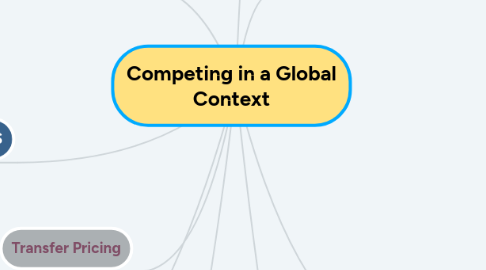
1. Globalisation
1.1. Ethical issues
1.1.1. Geographical segregation
1.1.1.1. Different cultures
1.1.2. Consumer standards
1.1.2.1. Different standards
1.1.2.2. Consumer protection
1.2. Expanding operations
1.2.1. Global expansion
1.2.1.1. Wider market
2. IFRS
2.1. Financial reporting
2.1.1. Unitary taxation
2.2. Financial regulations
2.2.1. Government
2.2.1.1. Legislations
3. Transfer Pricing
3.1. Tax avoidance
3.1.1. BEPS
3.2. Illegal
3.2.1. Transfer mis-pricing
3.3. Arms length principle
4. Corporate & Social Responsibility (CSR)
4.1. Taking responisbility
4.1.1. Impact businesses have
4.1.2. Conduct of businesses
4.2. Government influence
4.2.1. Regulations
4.3. Profitable market system
4.4. Brand misconduct
4.4.1. Unethical activities
4.4.1.1. Negative impact
4.4.1.2. Unethical labour practices
4.4.1.2.1. Supply chain
4.4.1.3. Ethical principles
5. Branding
5.1. Identity
5.1.1. Logo
5.1.2. Internal formation
5.2. Marketing
5.2.1. Design
5.2.1.1. Packaging
5.3. Reputation
5.3.1. External evaluation
5.3.2. Past actions/results
5.3.2.1. Services
5.3.2.2. Negative/Positive feedback
6. Global Trade Environment
6.1. Worldwide buying & selling
6.1.1. Advancement in ICT
6.1.1.1. Interconectedness
6.2. Global economy
6.2.1. World Trade Organisation (WTO)
6.2.1.1. Global rules of trade
6.2.1.1.1. Trade agreements
7. Foreign Exchange Market
7.1. Exchange rates
7.1.1. Fixed by Governments
7.1.1.1. Government intervention
7.1.1.1.1. Increase in interest rates
7.1.2. Currencies
7.1.2.1. Currency markets
7.1.2.1.1. Supply
8. Economic & Financial Flows
8.1. Global imbalances
8.1.1. Financial account
8.1.2. Large deficits
8.1.3. Surpluses
8.1.3.1. Capital account
8.1.3.2. Current account
8.2. Foreign direct investments (FDIs)
8.2.1. Securing operating control
8.2.2. Investments made by countries
8.3. Balance of payments
8.3.1. Current account
8.3.1.1. Income
8.3.1.2. Payments
8.3.1.2.1. Imports & Exports
8.3.1.3. Transfers
8.3.2. Capital account
8.3.2.1. Records transfers of capital
8.3.2.1.1. One country to another
8.3.3. Financial account
8.3.3.1. Covers claims & Liabilities
8.3.3.2. Financial assests
8.3.3.2.1. Reserves assests
8.3.3.3. Direct investments
8.3.3.4. Portfolio investments
8.3.3.5. Records financial in flows
9. International Marketing
9.1. Direct exporting
9.1.1. Intermediaries
9.1.1.1. Expensive
9.1.2. Interenet
9.1.2.1. Advancement in technology
9.2. Micro Environment
9.3. Macro Environment
9.4. Indirect exporting
9.4.1. Less risk
9.4.2. Less investment
